Archaeology
As you journey the Cannon Valley Trail, you are following the footsteps of many generations of earlier people who have traveled this beautiful and peaceful valley. 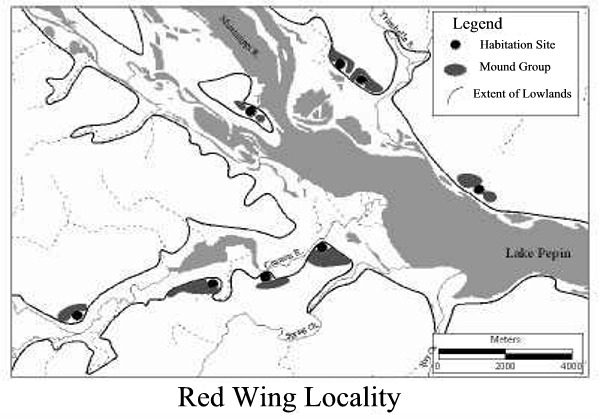 Scattered along andnear the trail are remnants of the camps, villages, and burial places of American Indian who occupied this land for perhaps 12,000 years before white settlers arrived. These sites are the principal sources we have to study and reconstruct what life was like between the end of the last glacial advance and the arrival of Europeans in the region in the late 17th century.
Scattered along andnear the trail are remnants of the camps, villages, and burial places of American Indian who occupied this land for perhaps 12,000 years before white settlers arrived. These sites are the principal sources we have to study and reconstruct what life was like between the end of the last glacial advance and the arrival of Europeans in the region in the late 17th century.
There are five distinct stages that are known in and around the Cannon River Valley. They are: Paleo-Indian Stage, Archaic Stage, Woodland Stage, Mississippian Stage, and Proto-historic Stage. These stages encompass changes in both the environment and technology and refer to artifact assemblages and the time periods during which they were made.
1) Paleo-Indian – Portions of southeastern Minnesota were not covered with ice when 14,000 years ago the landscape was dominated by the great masses of the Des Moines and Superior Lakes, however, people may have lived in the spruce forests that covered this area. As the ice masses retreated, the vegetation of the landscape changed and spruce forests moved north, followed by a mix of deciduous and pine forests. No Paleo-Indian site has yet been excavated in Minnesota. However, we occasionally find tools from this period.
2) Archaic – By 9,000 years ago the direct effects of the glacial ice sheets were no longer being felt in southeastern Minnesota and the vegetation had stabilized somewhat. Many of the earlier large animals had become extinct, the climate became increasingly warm and dry and the prairie eastward to the far side of the Mississippi River. This period is characterized by the appearance of e new tools and technologies.
3) Woodland Stage – By 3,000 years ago the animal population and vegetation of southeastern Minnesota had become very similar to what it is today. The Woodland Stage has a period of time during which hunting and gathering became exceptionally effective in exploiting the environment. It’s characterized by the appearances of ceramics, the first construction of earthen mounds, and increasing population size, the appearance of distinctive artifact assemblages. The intro of pottery is particularly important development. It implies that groups of people were increasingly sedentary and were not quite as mobile as earlier groups.
4) Mississippian – About 1,000 years A.D. several developments occurred that revolutionized the life of American Indian people in the upper Midwest, including the adoption of farming (in contrast to hunting and gathering), the use of fresh water clam shell to temper ceramics, appearance of bow and arrow and the development of long distance trade networks and more complex forms of social organization. The Mississippian period is well represented at the mouth of the Cannon River and indeed the Cannon-Mississippi junction was the most densely populated area of the Upper Mississippi Valley during this period. There are two distinct archaeological cultures present at the mouth of the Cannon during this period and these groups are distinguished principally on the basis of ceramics that they manufactured. Oneota cultures appear to have been indigenous groups that developed in the earlier Woodland cultures while the Silvernale Phase culture appears to have more affinities with the Mississippian groups farther to the south in Kentucky, Illinois, Indiana, Iowa, Missouri and Arkansas.
5) Protohistoric- The densely populated area that characterized the previous 250 years is no longer present and the silvernale phase culture disappears. The reasons for this abrupt decline in culture are still unknown but appear to be tied to the decline of the major Mississippian population center Cahokia and the depletion of Natural Resources in the region by these prehistoric groups. Around 1550 a climatic episode known as the little Ice Ages began and agriculture seemed to have played a less significant role than before. Sometime during the mid 17th century the Dakota people moved into the Cannon River Area and it was these Indians who met the first white explores ascending the Mississippi River.
Only a few of the sites on or near the Cannon Valley Trail have been excavated. Many of the sites are on private properly and are extremely fragile. Here is some of the more interesting sites.
1) Late Paleo-Indian/Early Archaic Sites– Only a few sites from this period are known to the Cannon River Area. Population Density was quite low and most sites small. Changes in landforms because of erosion and aggradation have destroyed or hidden most of these sites. There came a rare opportunity for archaeologists in 1987 when several areas containing artifacts form this period were discovered eroding along the banks of the river. The sites were located near marshy areas in the floodplain of the river. The tools and artifacts found suggest that the old inhabitants of these sites were using these sites for two purposes, processing food resources from the river valley and manufacturing tools from the Prairie du Chien chert nodules weathering out of the nearby bedrock.
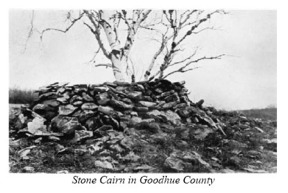
2) Stone Cairns Archaeologists have yet to unravel many mysteries, one of them is one that surrounds a series of stone heaps or cairns found on some bluffs overlooking the Cannon and Mississippi Rivers. Similar stone mounds are common in places like Illinois, Kentucky, Indiana but they are extremely rare in the upper Mississippi country. There has been no professional archaeologist able to investigate theses stone Cairns and today they have been vandalized or destroyed by modern activities.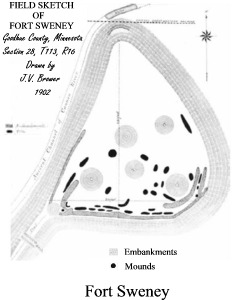
3) Fort Sweney- Fort Sweney is situated on a high bluff overlooking the Cannon River and is one of the most pre-contact mysteries along the Cannon Valley Trail. This site contains a complex series of pits and an earthen circular enclosure, with several tumuli mounds nearby. The site has been badly disturbed by digging by both vandals and archaeologists but you can still trace the outlines of the enclosure and mounds. This site was named in honor of Dr. W.M. Sweney.
4) Bryan Site- Spring of ’51, equipment operators at a newly opened gravel pit along the Cannon River were startled to observe human skeletons intermixed with the gravel they were mining. Professor Lloyd Wilford at the University of Minnesota was contacted and immediately visited the site and found the workmen had discovered a major town site dating back to the beginning of the 2nd millennia A.D. Investigation revealed that the site covered about 65 acres and consisted of a large group of 173 mounds. The site was named the Bryan Site after the family that owned the property since the end of the 19th century.
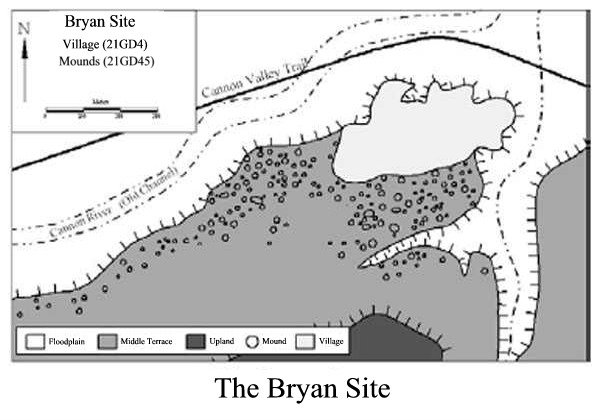
5) Energy Park Site- In September 1885 T.H. Lewis of the Northwestern Archaeological Survey Mapped out a group of 64 mounds that were located on a bluff top overlooking the confluence of the Cannon and Mississippi Rivers. 100 years after Lewis’ visit to the site, archaeologists discovered a village site of about eight acres located between the mounds and the bluff edge. This discovery was particularly important since it is possible that the elite individuals who used the flat-topped mound may have lived in this nearby village. Further excavations at the site will hopefully uncover the actual structures that these people lived in and allow us to recreate in detail the story of early life in an American Indian trading and farming village along the Cannon.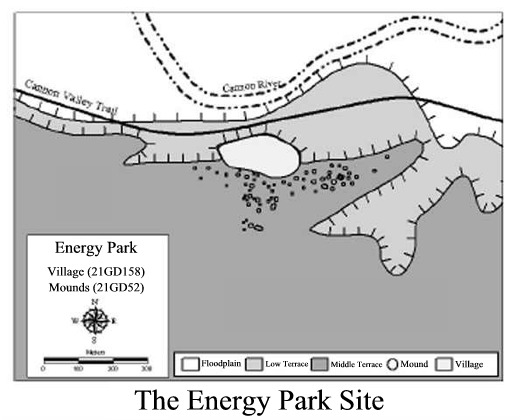
Important research continues on the archaeology of the Red Wing area, specifically the sites found along the Cannon Valley Trail. The continued support and involvement of professional archaeologists, institutions and agencies, as well as the public are essential in keeping regional archaeology at the forefront of preservation, research, interpretation and stewardship.
